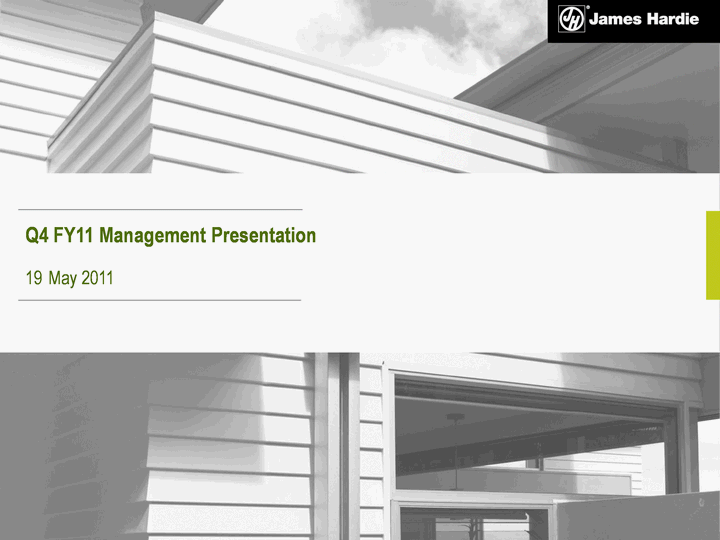

| Q4 FY11 Management Presentation 19 May 2011 |
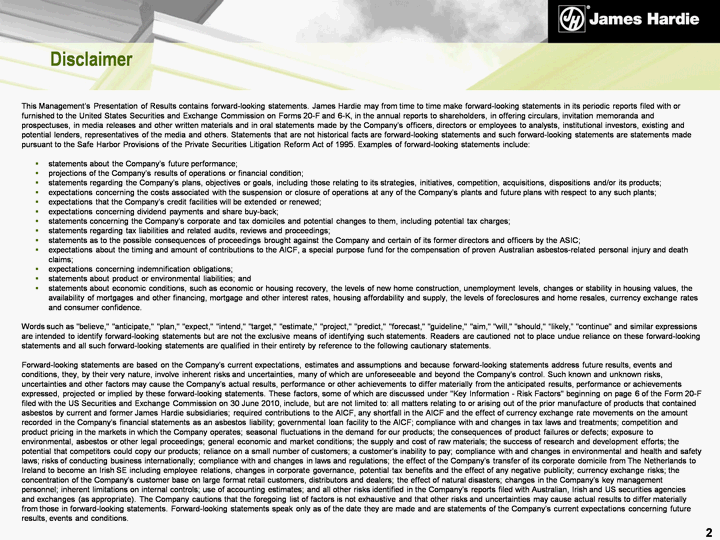
| Disclaimer This Management's Presentation of Results contains forward-looking statements. James Hardie may from time to time make forward-looking statements in its periodic reports filed with or furnished to the United States Securities and Exchange Commission on Forms 20-F and 6-K, in the annual reports to shareholders, in offering circulars, invitation memoranda and prospectuses, in media releases and other written materials and in oral statements made by the Company's officers, directors or employees to analysts, institutional investors, existing and potential lenders, representatives of the media and others. Statements that are not historical facts are forward-looking statements and such forward-looking statements are statements made pursuant to the Safe Harbor Provisions of the Private Securities Litigation Reform Act of 1995. Examples of forward-looking statements include: statements about the Company's future performance; projections of the Company's results of operations or financial condition; statements regarding the Company's plans, objectives or goals, including those relating to its strategies, initiatives, competition, acquisitions, dispositions and/or its products; expectations concerning the costs associated with the suspension or closure of operations at any of the Company's plants and future plans with respect to any such plants; expectations that the Company's credit facilities will be extended or renewed; expectations concerning dividend payments and share buy-back; statements concerning the Company's corporate and tax domiciles and potential changes to them, including potential tax charges; statements regarding tax liabilities and related audits, reviews and proceedings; statements as to the possible consequences of proceedings brought against the Company and certain of its former directors and officers by the ASIC; expectations about the timing and amount of contributions to the AICF, a special purpose fund for the compensation of proven Australian asbestos-related personal injury and death claims; expectations concerning indemnification obligations; statements about product or environmental liabilities; and statements about economic conditions, such as economic or housing recovery, the levels of new home construction, unemployment levels, changes or stability in housing values, the availability of mortgages and other financing, mortgage and other interest rates, housing affordability and supply, the levels of foreclosures and home resales, currency exchange rates and consumer confidence. Words such as "believe," "anticipate," "plan," "expect," "intend," "target," "estimate," "project," "predict," "forecast," "guideline," "aim," "will," "should," "likely," "continue" and similar expressions are intended to identify forward-looking statements but are not the exclusive means of identifying such statements. Readers are cautioned not to place undue reliance on these forward-looking statements and all such forward-looking statements are qualified in their entirety by reference to the following cautionary statements. Forward-looking statements are based on the Company's current expectations, estimates and assumptions and because forward-looking statements address future results, events and conditions, they, by their very nature, involve inherent risks and uncertainties, many of which are unforeseeable and beyond the Company's control. Such known and unknown risks, uncertainties and other factors may cause the Company's actual results, performance or other achievements to differ materially from the anticipated results, performance or achievements expressed, projected or implied by these forward-looking statements. These factors, some of which are discussed under "Key Information - Risk Factors" beginning on page 6 of the Form 20-F filed with the US Securities and Exchange Commission on 30 June 2010, include, but are not limited to: all matters relating to or arising out of the prior manufacture of products that contained asbestos by current and former James Hardie subsidiaries; required contributions to the AICF, any shortfall in the AICF and the effect of currency exchange rate movements on the amount recorded in the Company's financial statements as an asbestos liability; governmental loan facility to the AICF; compliance with and changes in tax laws and treatments; competition and product pricing in the markets in which the Company operates; seasonal fluctuations in the demand for our products; the consequences of product failures or defects; exposure to environmental, asbestos or other legal proceedings; general economic and market conditions; the supply and cost of raw materials; the success of research and development efforts; the potential that competitors could copy our products; reliance on a small number of customers; a customer's inability to pay; compliance with and changes in environmental and health and safety laws; risks of conducting business internationally; compliance with and changes in laws and regulations; the effect of the Company's transfer of its corporate domicile from The Netherlands to Ireland to become an Irish SE including employee relations, changes in corporate governance, potential tax benefits and the effect of any negative publicity; currency exchange risks; the concentration of the Company's customer base on large format retail customers, distributors and dealers; the effect of natural disasters; changes in the Company's key management personnel; inherent limitations on internal controls; use of accounting estimates; and all other risks identified in the Company's reports filed with Australian, Irish and US securities agencies and exchanges (as appropriate). The Company cautions that the foregoing list of factors is not exhaustive and that other risks and uncertainties may cause actual results to differ materially from those in forward-looking statements. Forward-looking statements speak only as of the date they are made and are statements of the Company's current expectations concerning future results, events and conditions. 2 |
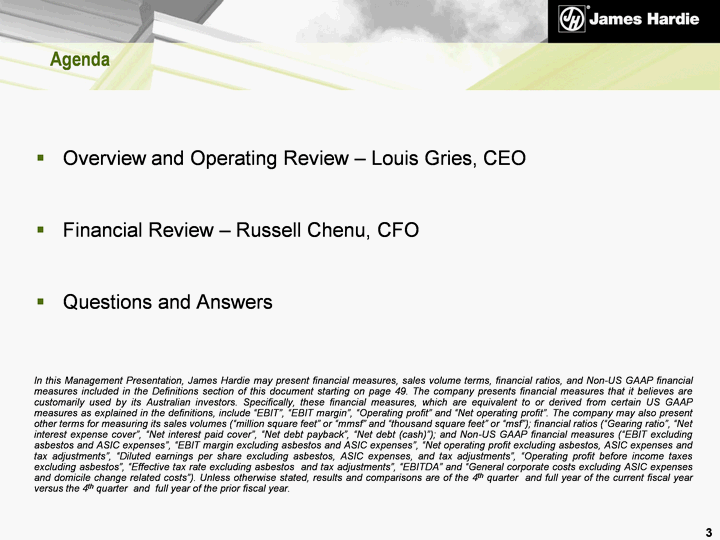
| Agenda Overview and Operating Review - Louis Gries, CEO Financial Review - Russell Chenu, CFO Questions and Answers 3 In this Management Presentation, James Hardie may present financial measures, sales volume terms, financial ratios, and Non-US GAAP financial measures included in the Definitions section of this document starting on page 49. The company presents financial measures that it believes are customarily used by its Australian investors. Specifically, these financial measures, which are equivalent to or derived from certain US GAAP measures as explained in the definitions, include "EBIT", "EBIT margin", "Operating profit" and "Net operating profit". The company may also present other terms for measuring its sales volumes ("million square feet" or "mmsf" and "thousand square feet" or "msf"); financial ratios ("Gearing ratio", "Net interest expense cover", "Net interest paid cover", "Net debt payback", "Net debt (cash)"); and Non-US GAAP financial measures ("EBIT excluding asbestos and ASIC expenses", "EBIT margin excluding asbestos and ASIC expenses", "Net operating profit excluding asbestos, ASIC expenses and tax adjustments", "Diluted earnings per share excluding asbestos, ASIC expenses, and tax adjustments", "Operating profit before income taxes excluding asbestos", "Effective tax rate excluding asbestos and tax adjustments", "EBITDA" and "General corporate costs excluding ASIC expenses and domicile change related costs"). Unless otherwise stated, results and comparisons are of the 4th quarter and full year of the current fiscal year versus the 4th quarter and full year of the prior fiscal year. |

| Operating Review Louis Gries, CEO |
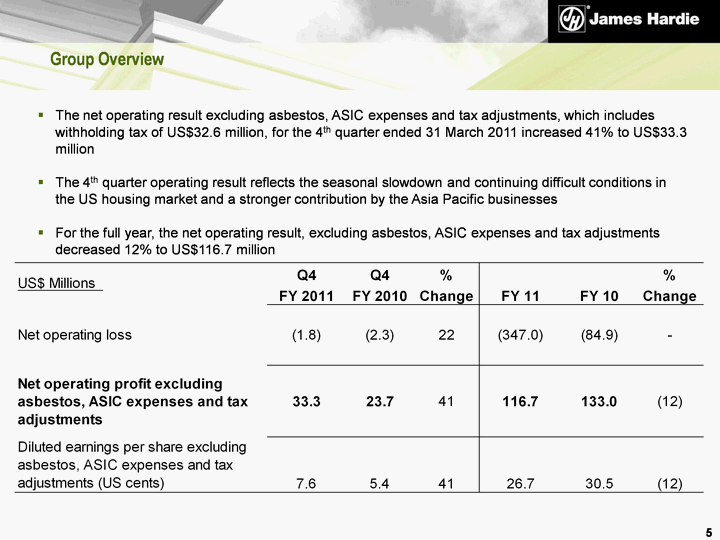
| Group Overview The net operating result excluding asbestos, ASIC expenses and tax adjustments, which includes withholding tax of US$32.6 million, for the 4th quarter ended 31 March 2011 increased 41% to US$33.3 million The 4th quarter operating result reflects the seasonal slowdown and continuing difficult conditions in the US housing market and a stronger contribution by the Asia Pacific businesses For the full year, the net operating result, excluding asbestos, ASIC expenses and tax adjustments decreased 12% to US$116.7 million 5 |
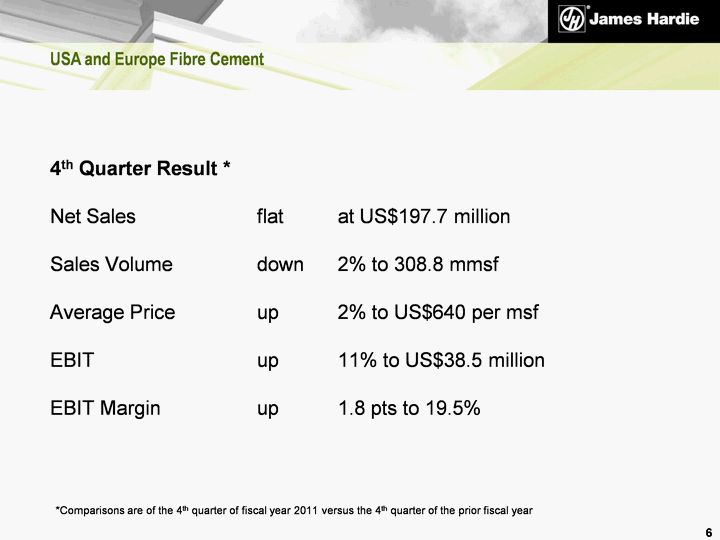
| 4th Quarter Result * Net Sales flat at US$197.7 million Sales Volume down 2% to 308.8 mmsf Average Price up 2% to US$640 per msf EBIT up 11% to US$38.5 million EBIT Margin up 1.8 pts to 19.5% 6 USA and Europe Fibre Cement *Comparisons are of the 4th quarter of fiscal year 2011 versus the 4th quarter of the prior fiscal year |
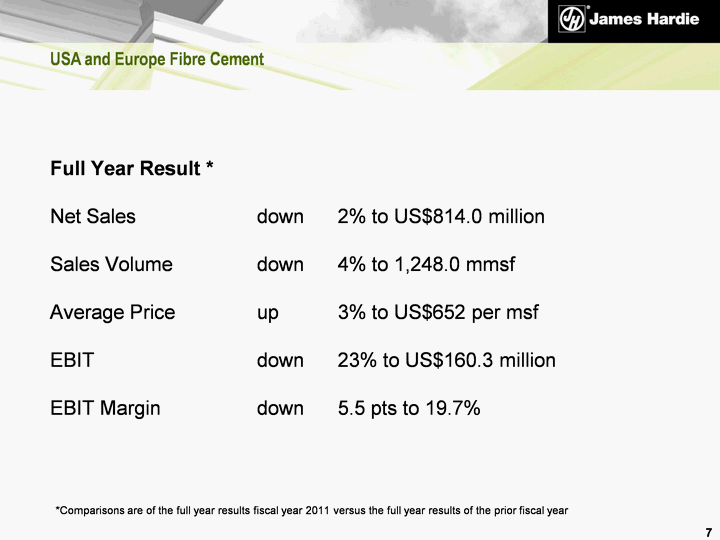
| Full Year Result * Net Sales down 2% to US$814.0 million Sales Volume down 4% to 1,248.0 mmsf Average Price up 3% to US$652 per msf EBIT down 23% to US$160.3 million EBIT Margin down 5.5 pts to 19.7% 7 USA and Europe Fibre Cement *Comparisons are of the full year results fiscal year 2011 versus the full year results of the prior fiscal year |
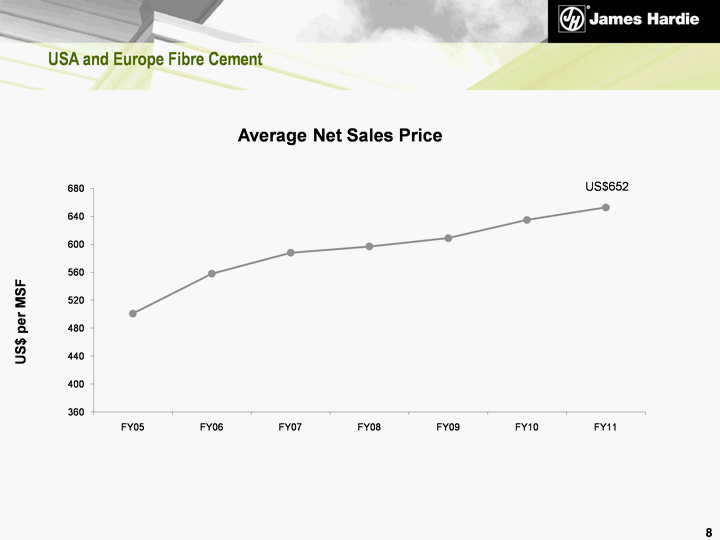
| (CHART) Average Net Sales Price US$ per MSF USA and Europe Fibre Cement US$652 8 |
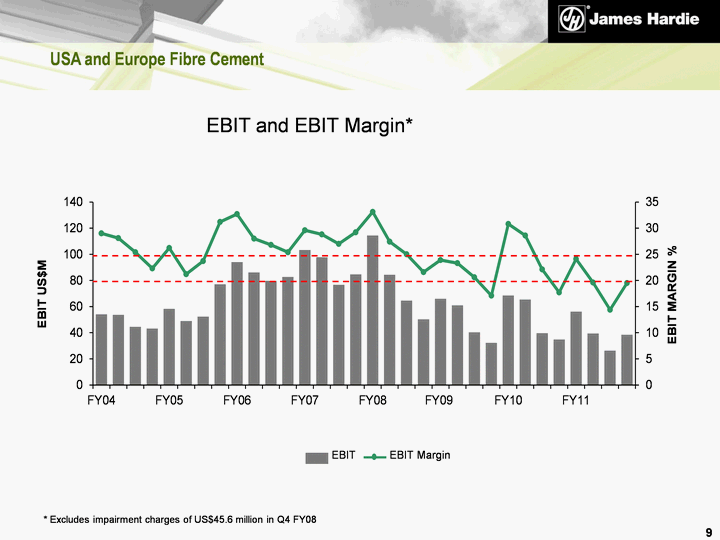
| USA and Europe Fibre Cement * Excludes impairment charges of US$45.6 million in Q4 FY08 9 EBIT and EBIT Margin* EBIT EBIT Margin |

| USA Fibre Cement Rolling 12 month average of seasonally adjusted estimate of housing starts by US Census Bureau 10 |
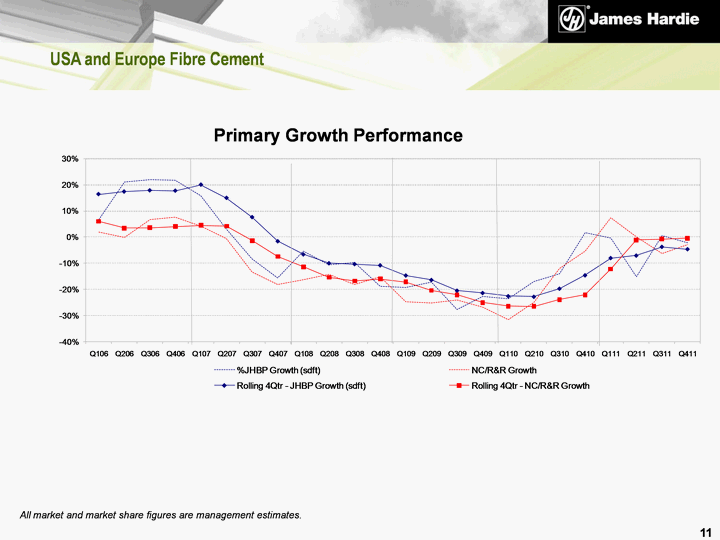
| USA and Europe Fibre Cement Primary Growth Performance All market and market share figures are management estimates. 11 |

| 4th Quarter Result * Net Sales up 16% to US$90.7 million Sales Volume up 5% to 102.1 mmsf Average Price flat at A$883 per msf EBIT up 36% to US$19.4 million EBIT Margin up 3.1 pts to 21.4% 12 Asia Pacific Fibre Cement *Comparisons are of the 4th quarter of fiscal year 2011 versus the 4th quarter of the prior fiscal year |
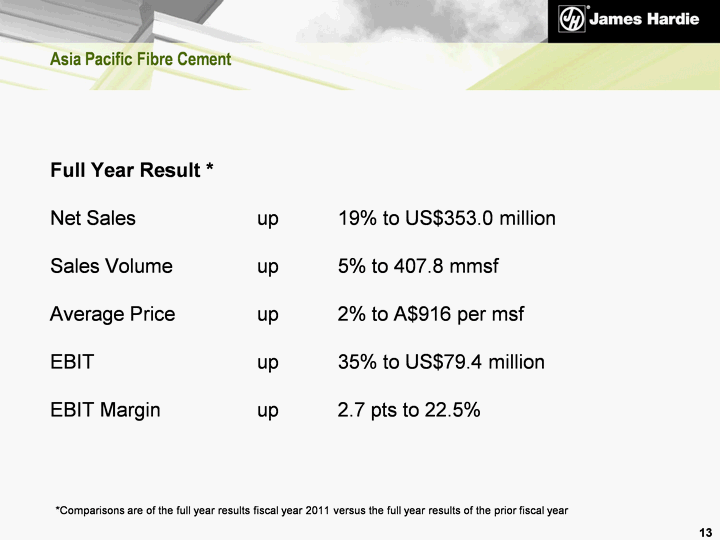
| Full Year Result * Net Sales up 19% to US$353.0 million Sales Volume up 5% to 407.8 mmsf Average Price up 2% to A$916 per msf EBIT up 35% to US$79.4 million EBIT Margin up 2.7 pts to 22.5% 13 Asia Pacific Fibre Cement *Comparisons are of the full year results fiscal year 2011 versus the full year results of the prior fiscal year |
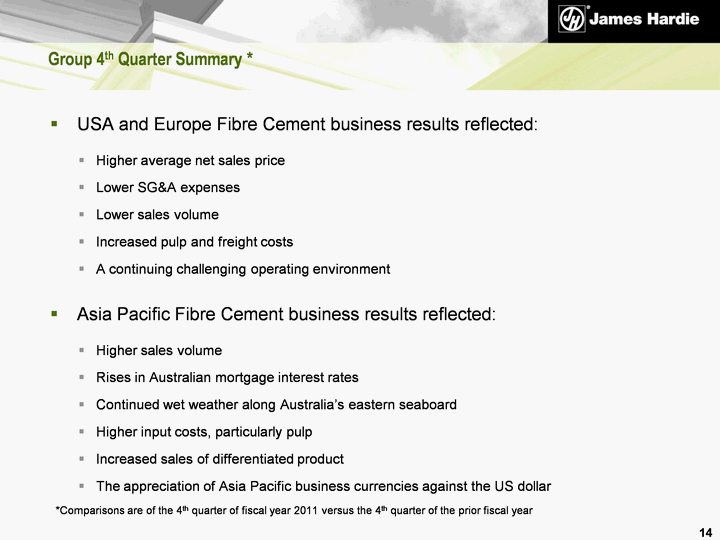
| 14 Group 4th Quarter Summary * *Comparisons are of the 4th quarter of fiscal year 2011 versus the 4th quarter of the prior fiscal year USA and Europe Fibre Cement business results reflected: Higher average net sales price Lower SG&A expenses Lower sales volume Increased pulp and freight costs A continuing challenging operating environment Asia Pacific Fibre Cement business results reflected: Higher sales volume Rises in Australian mortgage interest rates Continued wet weather along Australia's eastern seaboard Higher input costs, particularly pulp Increased sales of differentiated product The appreciation of Asia Pacific business currencies against the US dollar |

| 15 US housing starts data remained weak in the fourth quarter Total USA Housing Starts - US Census Bureau |
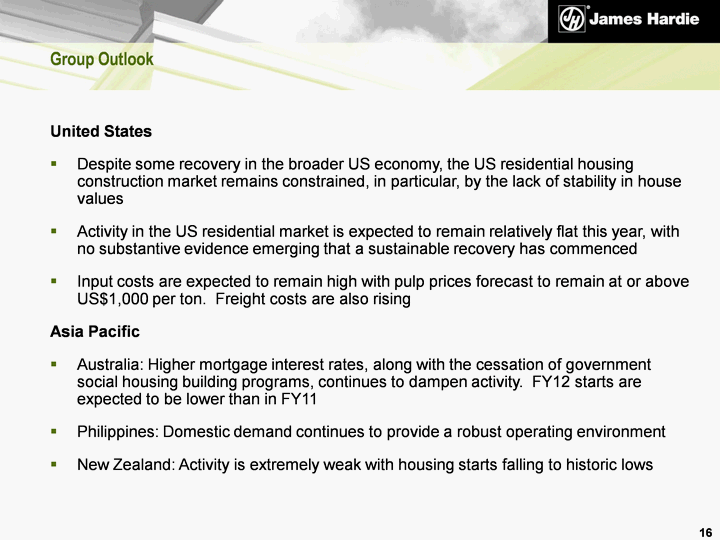
| Group Outlook 16 United States Despite some recovery in the broader US economy, the US residential housing construction market remains constrained, in particular, by the lack of stability in house values Activity in the US residential market is expected to remain relatively flat this year, with no substantive evidence emerging that a sustainable recovery has commenced Input costs are expected to remain high with pulp prices forecast to remain at or above US$1,000 per ton. Freight costs are also rising Asia Pacific Australia: Higher mortgage interest rates, along with the cessation of government social housing building programs, continues to dampen activity. FY12 starts are expected to be lower than in FY11 Philippines: Domestic demand continues to provide a robust operating environment New Zealand: Activity is extremely weak with housing starts falling to historic lows |
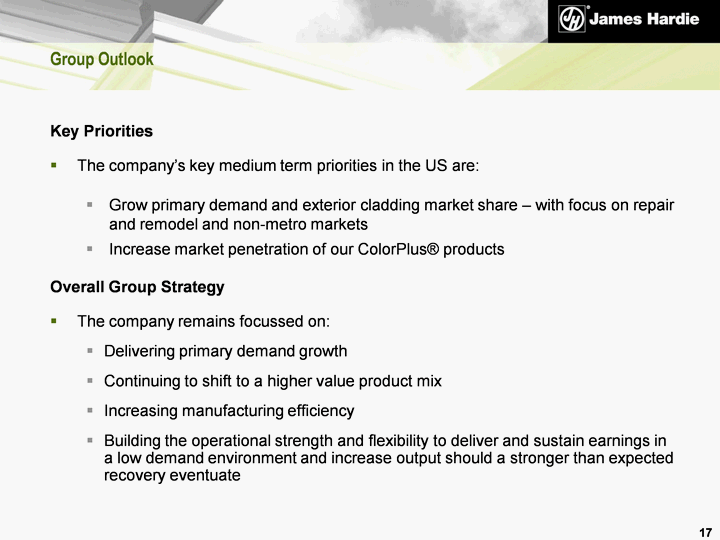
| 17 Group Outlook Key Priorities The company's key medium term priorities in the US are: Grow primary demand and exterior cladding market share - with focus on repair and remodel and non-metro markets Increase market penetration of our ColorPlus(r) products Overall Group Strategy The company remains focussed on: Delivering primary demand growth Continuing to shift to a higher value product mix Increasing manufacturing efficiency Building the operational strength and flexibility to deliver and sustain earnings in a low demand environment and increase output should a stronger than expected recovery eventuate |
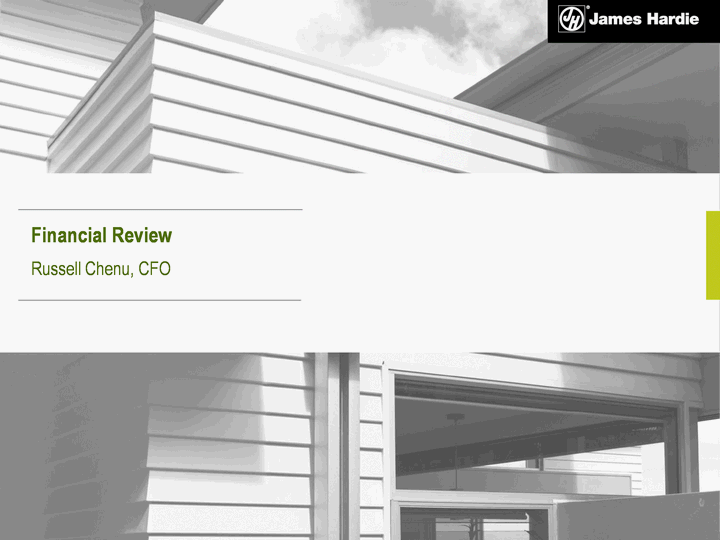
| Financial Review Russell Chenu, CFO |

| Overview 19 Operations Results for the full year reflect the weak US housing construction market, partially offset by the strong performance of the Asia Pacific businesses and lower SG&A expenses Strong net cash flow generation in the full year has enabled a further reduction in net debt by US$94.4 million to US$40.4 million since March 2010 The reduced level of debt, along with a reduction in the number of company specific contingencies and a strengthened confidence in the business' ability to adapt and meet the challenges of the continuing tough operating environment has enabled the Board to announce the resumption of an active approach to capital management Reinstatement of dividends in FY12 - 20% to 30% payout ratio Share buyback of up to 5% of issued capital |
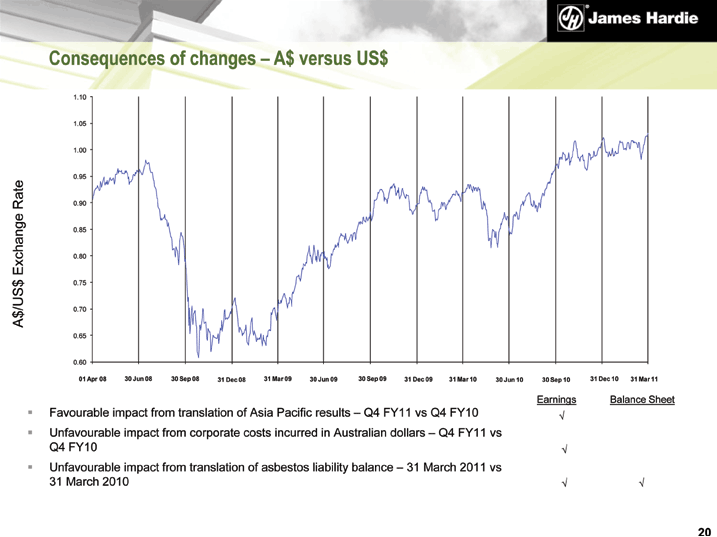
| Consequences of changes - A$ versus US$ A$/US$ Exchange Rate Favourable impact from translation of Asia Pacific results - Q4 FY11 vs Q4 FY10 Unfavourable impact from corporate costs incurred in Australian dollars - Q4 FY11 vs Q4 FY10 Unfavourable impact from translation of asbestos liability balance - 31 March 2011 vs 31 March 2010 20 Earnings Balance Sheet ^ ^ ^ ^ |

| Results - Q4 21 1 Includes a charge of US$32.6 million arising from the company's corporate structure simplification, as announced on 17 May 2011, which will be paid during the 2012 financial year |
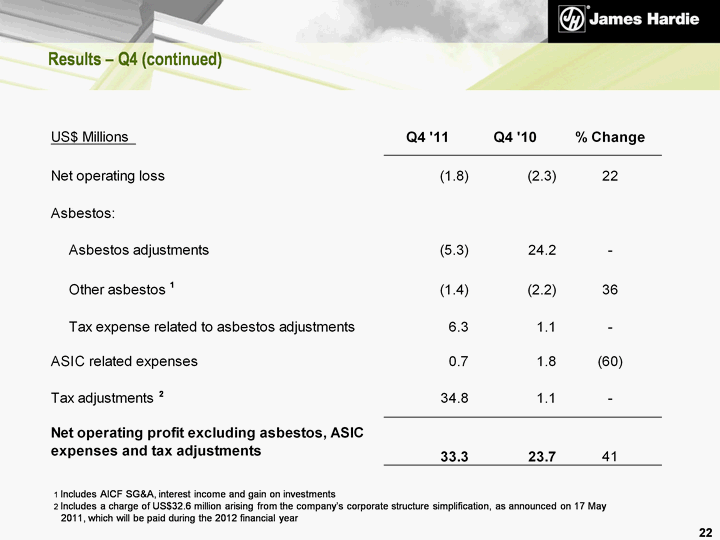
| Results - Q4 (continued) 22 1 Includes AICF SG&A, interest income and gain on investments 2 Includes a charge of US$32.6 million arising from the company's corporate structure simplification, as announced on 17 May 2011, which will be paid during the 2012 financial year |
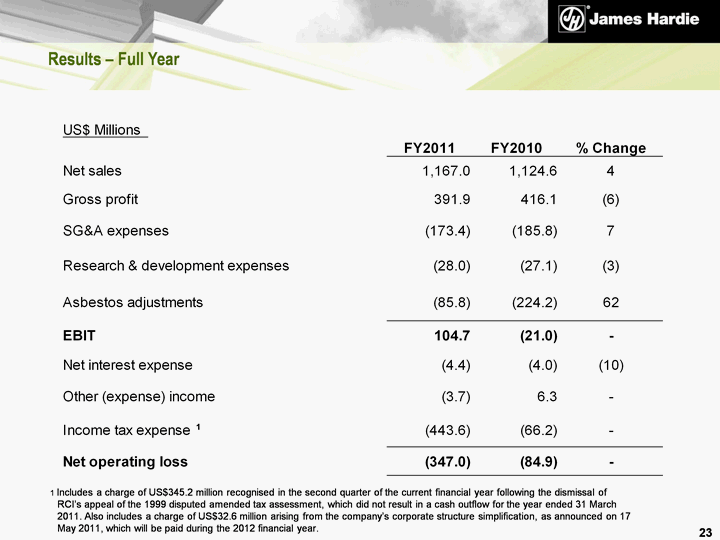
| Results - Full Year 23 1 Includes a charge of US$345.2 million recognised in the second quarter of the current financial year following the dismissal of RCI's appeal of the 1999 disputed amended tax assessment, which did not result in a cash outflow for the year ended 31 March 2011. Also includes a charge of US$32.6 million arising from the company's corporate structure simplification, as announced on 17 May 2011, which will be paid during the 2012 financial year. |
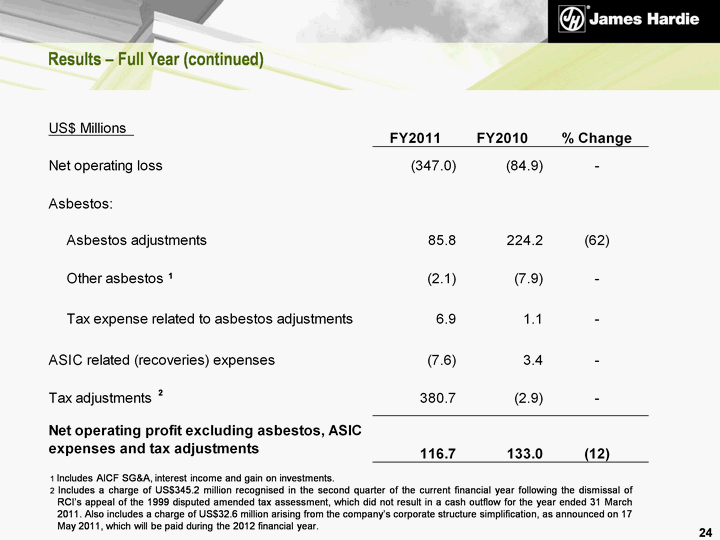
| Results - Full Year (continued) 24 1 Includes AICF SG&A, interest income and gain on investments. 2 Includes a charge of US$345.2 million recognised in the second quarter of the current financial year following the dismissal of RCI's appeal of the 1999 disputed amended tax assessment, which did not result in a cash outflow for the year ended 31 March 2011. Also includes a charge of US$32.6 million arising from the company's corporate structure simplification, as announced on 17 May 2011, which will be paid during the 2012 financial year. |
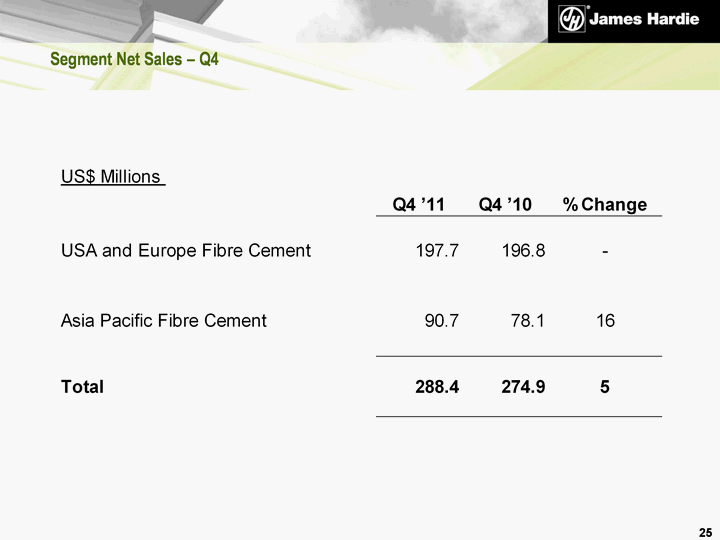
| Segment Net Sales - Q4 25 |
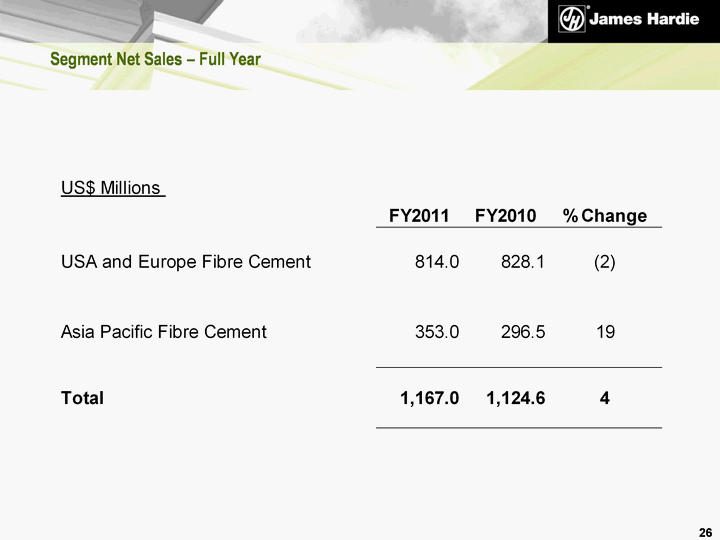
| Segment Net Sales - Full Year 26 |
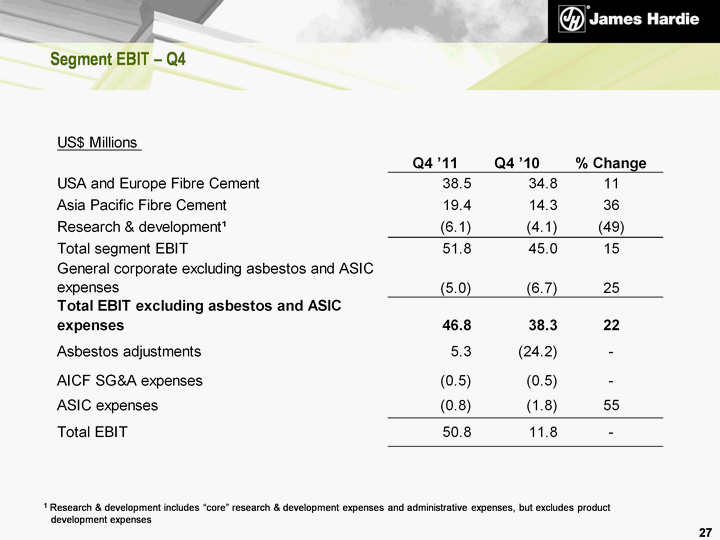
| 1 Research & development includes "core" research & development expenses and administrative expenses, but excludes product development expenses Segment EBIT - Q4 27 |
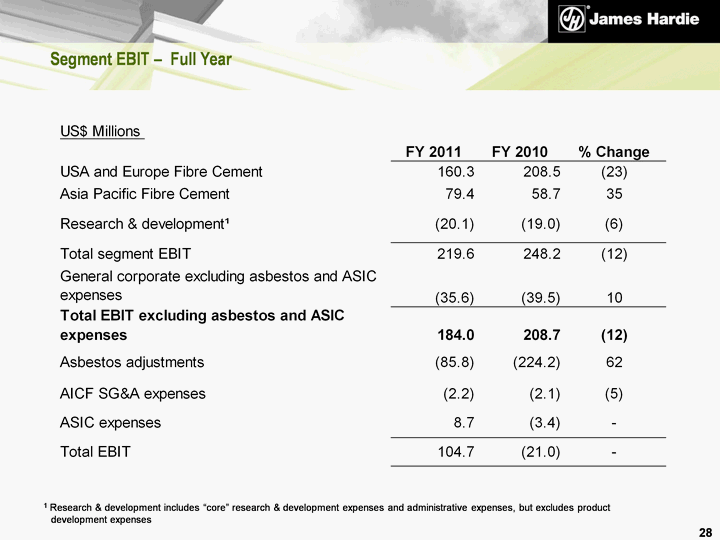
| 1 Research & development includes "core" research & development expenses and administrative expenses, but excludes product development expenses Segment EBIT - Full Year 28 |
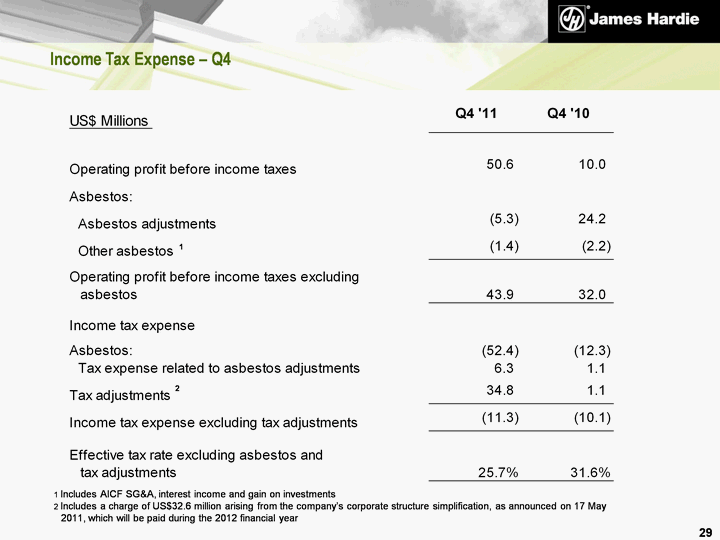
| Income Tax Expense - Q4 29 1 Includes AICF SG&A, interest income and gain on investments 2 Includes a charge of US$32.6 million arising from the company's corporate structure simplification, as announced on 17 May 2011, which will be paid during the 2012 financial year |
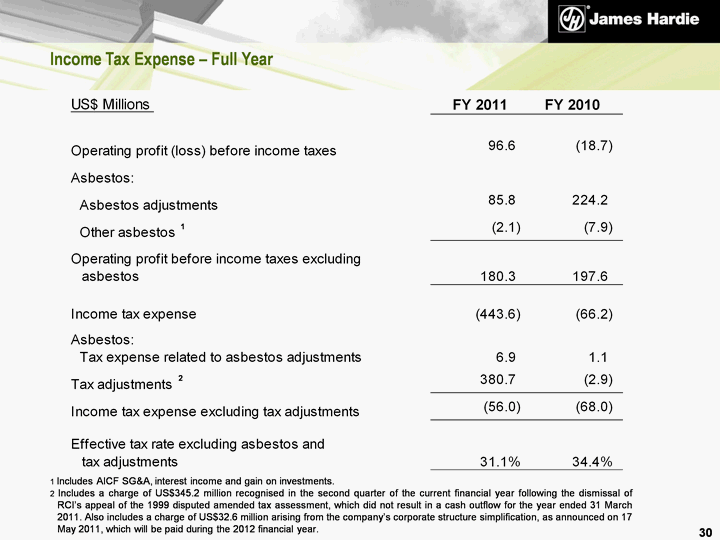
| Income Tax Expense - Full Year 30 1 Includes AICF SG&A, interest income and gain on investments. 2 Includes a charge of US$345.2 million recognised in the second quarter of the current financial year following the dismissal of RCI's appeal of the 1999 disputed amended tax assessment, which did not result in a cash outflow for the year ended 31 March 2011. Also includes a charge of US$32.6 million arising from the company's corporate structure simplification, as announced on 17 May 2011, which will be paid during the 2012 financial year. |
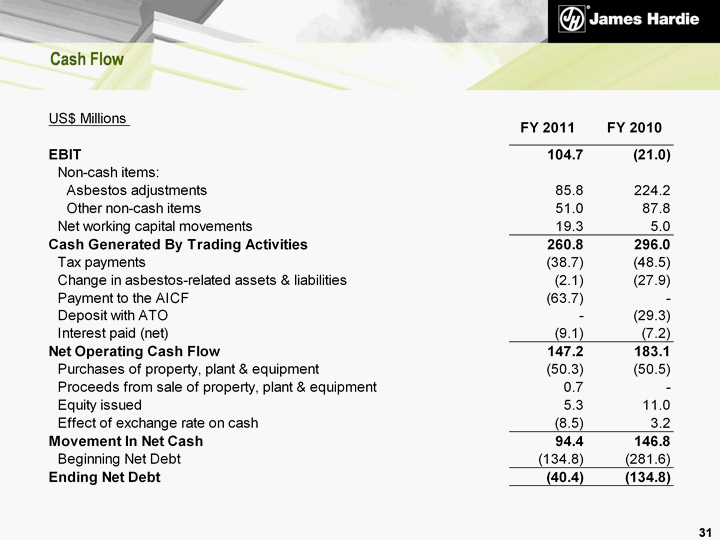
| Cash Flow 31 |
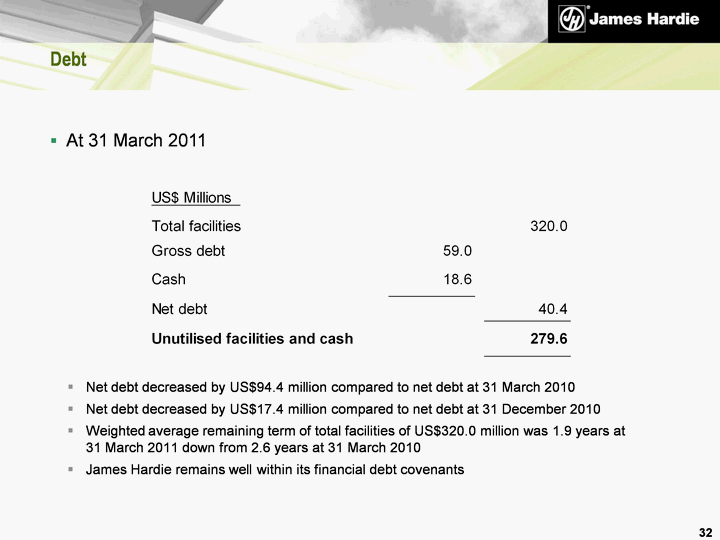
| Debt Net debt decreased by US$94.4 million compared to net debt at 31 March 2010 Net debt decreased by US$17.4 million compared to net debt at 31 December 2010 Weighted average remaining term of total facilities of US$320.0 million was 1.9 years at 31 March 2011 down from 2.6 years at 31 March 2010 James Hardie remains well within its financial debt covenants 32 At 31 March 2011 |
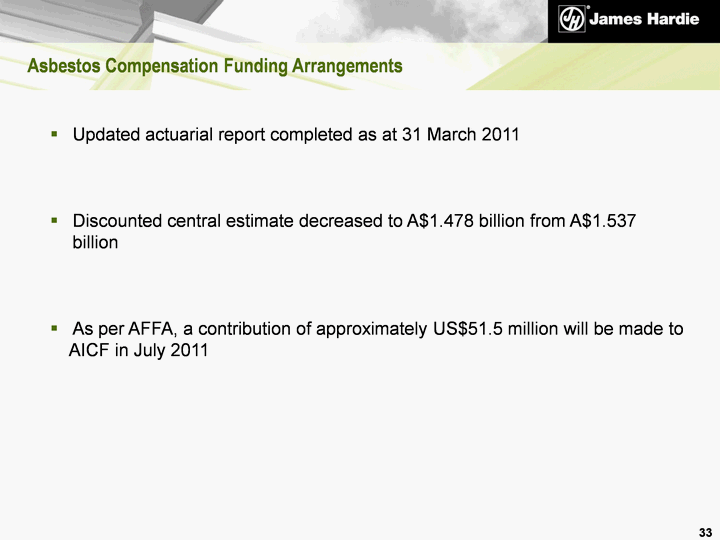
| Asbestos Compensation Funding Arrangements 33 Updated actuarial report completed as at 31 March 2011 Discounted central estimate decreased to A$1.478 billion from A$1.537 billion As per AFFA, a contribution of approximately US$51.5 million will be made to AICF in July 2011 |
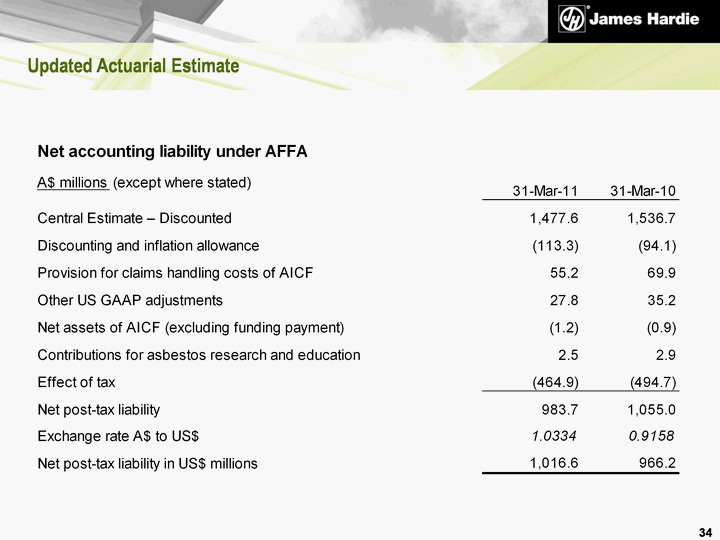
| Updated Actuarial Estimate 34 |
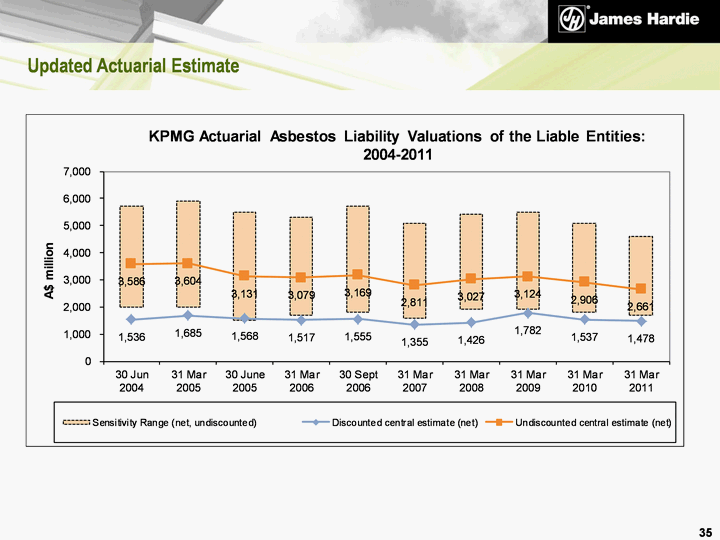
| Updated Actuarial Estimate 35 |
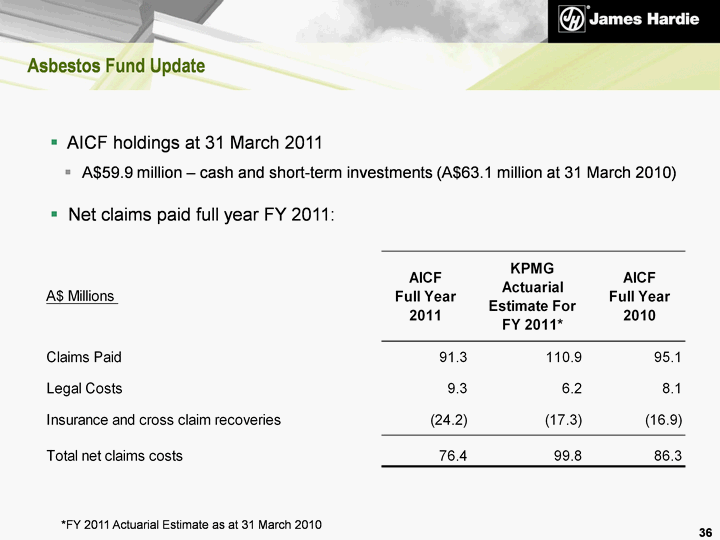
| Asbestos Fund Update 36 AICF holdings at 31 March 2011 A$59.9 million - cash and short-term investments (A$63.1 million at 31 March 2010) Net claims paid full year FY 2011: *FY 2011 Actuarial Estimate as at 31 March 2010 |
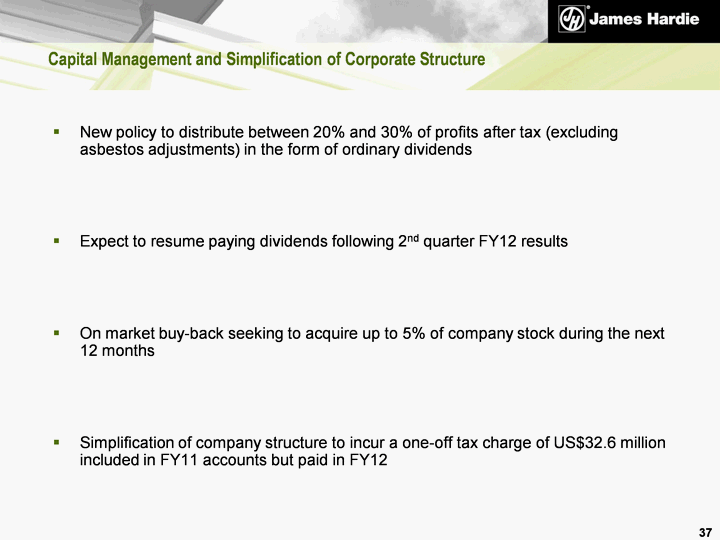
| 37 Capital Management and Simplification of Corporate Structure New policy to distribute between 20% and 30% of profits after tax (excluding asbestos adjustments) in the form of ordinary dividends Expect to resume paying dividends following 2nd quarter FY12 results On market buy-back seeking to acquire up to 5% of company stock during the next 12 months Simplification of company structure to incur a one-off tax charge of US$32.6 million included in FY11 accounts but paid in FY12 |
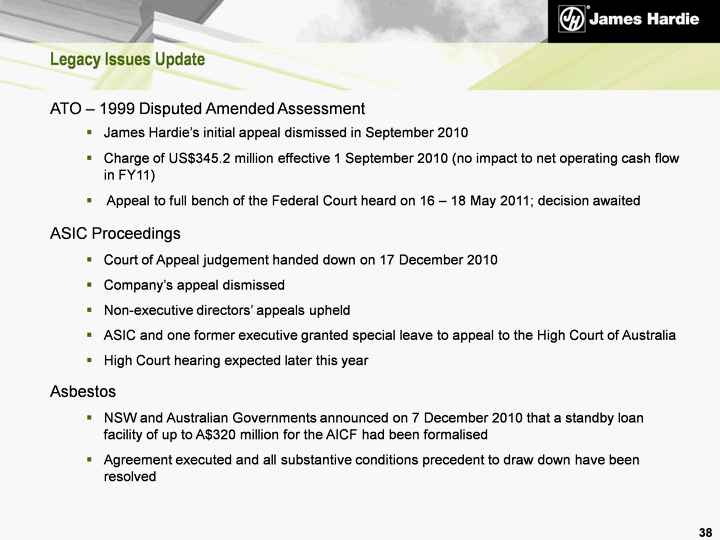
| Legacy Issues Update 38 ATO - 1999 Disputed Amended Assessment James Hardie's initial appeal dismissed in September 2010 Charge of US$345.2 million effective 1 September 2010 (no impact to net operating cash flow in FY11) Appeal to full bench of the Federal Court heard on 16 - 18 May 2011; decision awaited ASIC Proceedings Court of Appeal judgement handed down on 17 December 2010 Company's appeal dismissed Non-executive directors' appeals upheld ASIC and one former executive granted special leave to appeal to the High Court of Australia High Court hearing expected later this year Asbestos NSW and Australian Governments announced on 7 December 2010 that a standby loan facility of up to A$320 million for the AICF had been formalised Agreement executed and all substantive conditions precedent to draw down have been resolved |
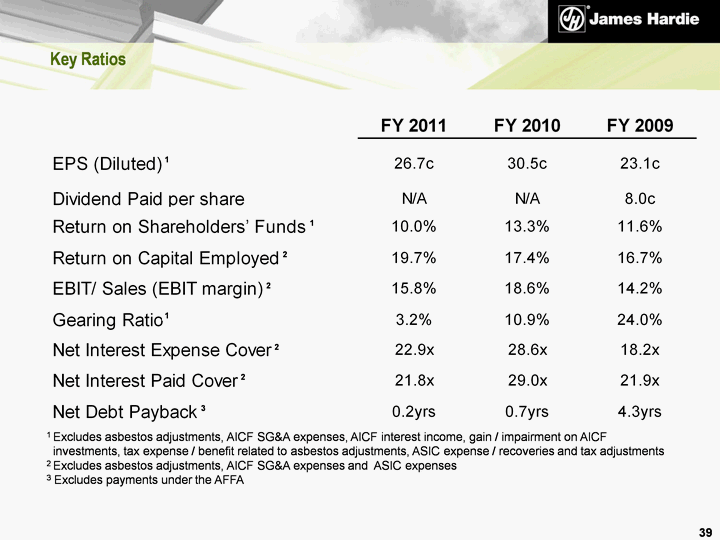
| Key Ratios 1 Excludes asbestos adjustments, AICF SG&A expenses, AICF interest income, gain / impairment on AICF investments, tax expense / benefit related to asbestos adjustments, ASIC expense / recoveries and tax adjustments 2 Excludes asbestos adjustments, AICF SG&A expenses and ASIC expenses 3 Excludes payments under the AFFA 39 |
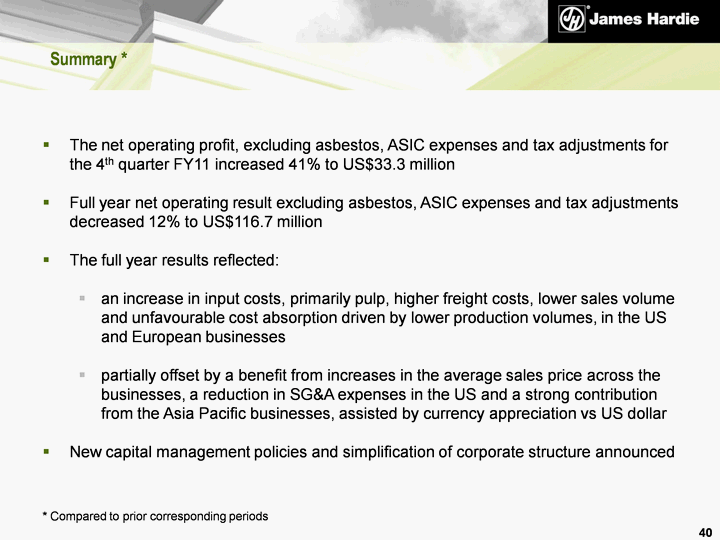
| 40 Summary * The net operating profit, excluding asbestos, ASIC expenses and tax adjustments for the 4th quarter FY11 increased 41% to US$33.3 million Full year net operating result excluding asbestos, ASIC expenses and tax adjustments decreased 12% to US$116.7 million The full year results reflected: an increase in input costs, primarily pulp, higher freight costs, lower sales volume and unfavourable cost absorption driven by lower production volumes, in the US and European businesses partially offset by a benefit from increases in the average sales price across the businesses, a reduction in SG&A expenses in the US and a strong contribution from the Asia Pacific businesses, assisted by currency appreciation vs US dollar New capital management policies and simplification of corporate structure announced * Compared to prior corresponding periods |

| Questions and Answers |
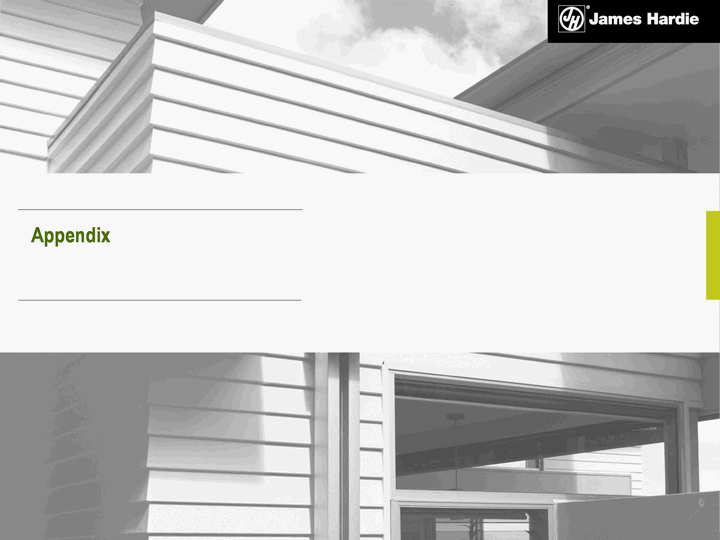
| Appendix |
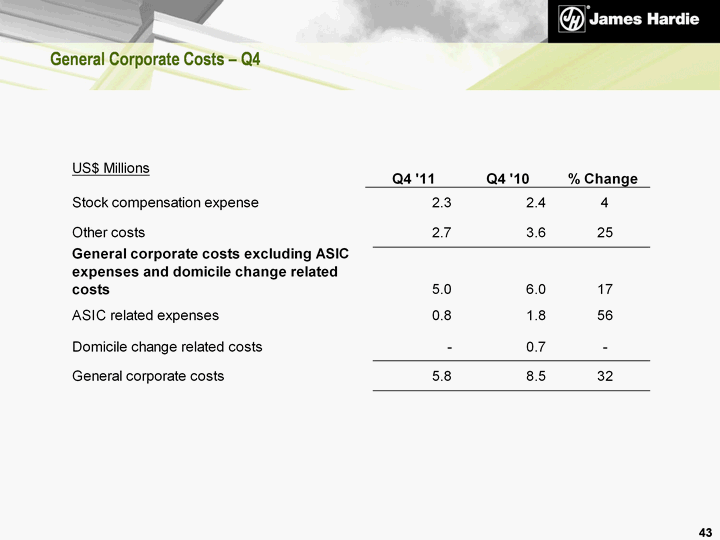
| General Corporate Costs - Q4 43 |
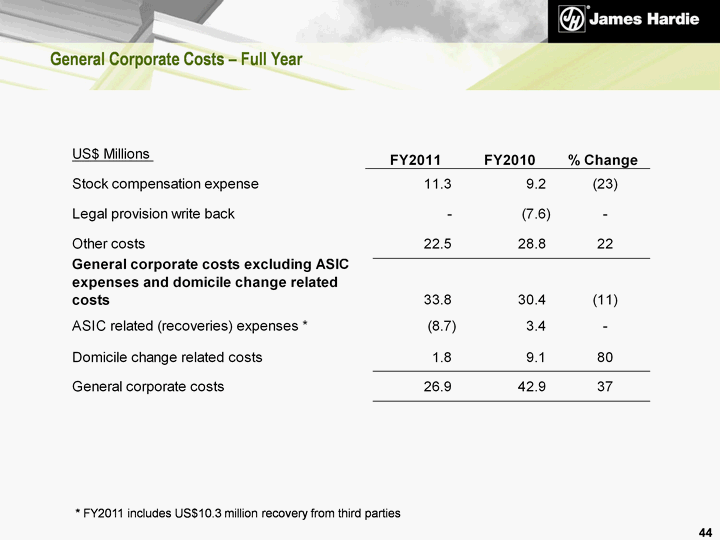
| General Corporate Costs - Full Year 44 * FY2011 includes US$10.3 million recovery from third parties |
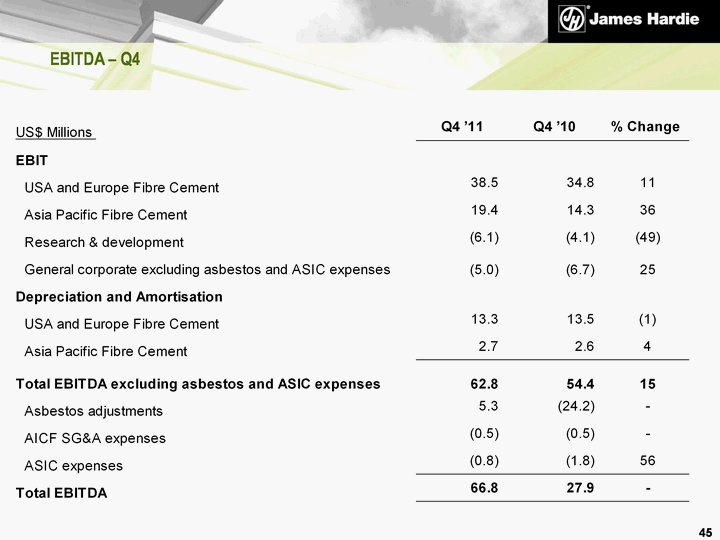
| EBITDA - Q4 45 |
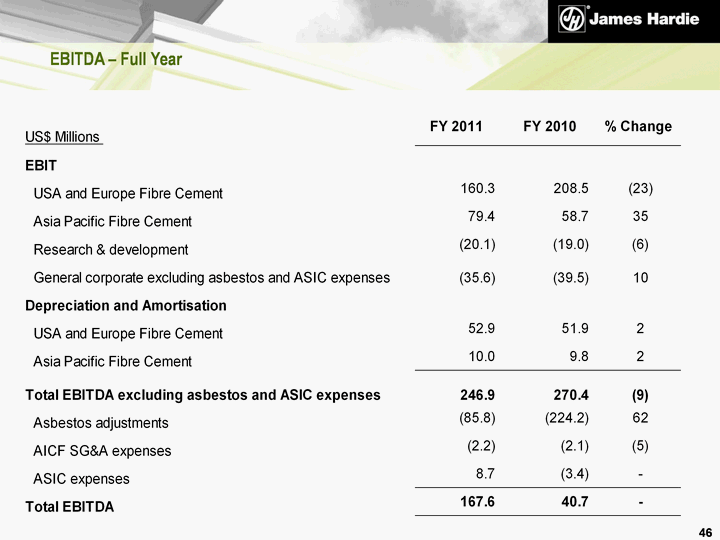
| EBITDA - Full Year 46 |
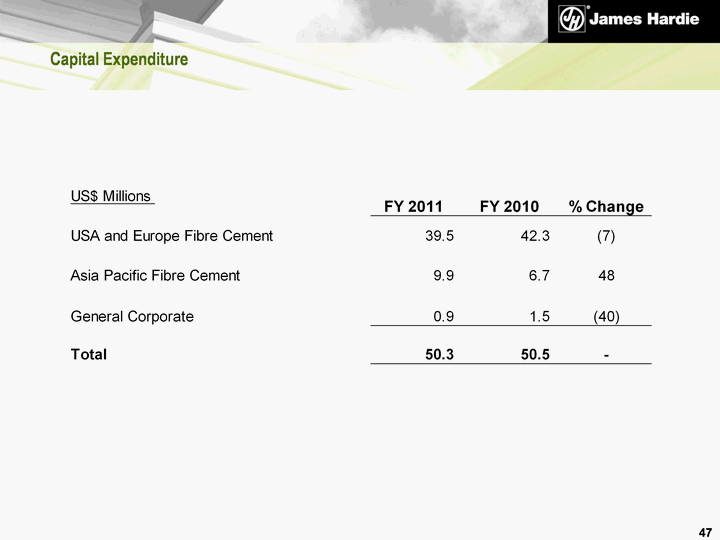
| Capital Expenditure 47 |
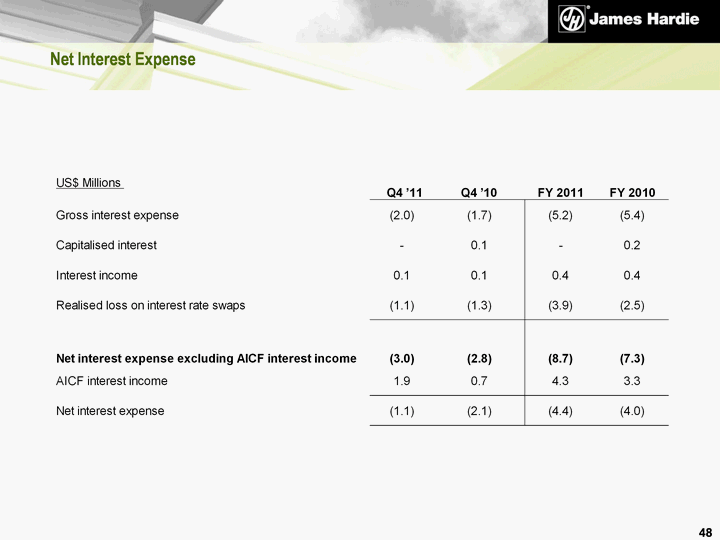
| Net Interest Expense 48 |

| Endnotes This Management Presentation forms part of a package of information about the company's results. It should be read in conjunction with the other parts of this package, including the Management's Analysis of Results, Media Release and Consolidated Financial Statements. Definitions Non-financial Terms ABS - Australian Bureau of Statistics. AFFA - Amended and Restated Final Funding Agreement. In February 2007, the company's shareholders approved the AFFA entered into on 21 November 2006 to provide long-term funding to Asbestos Injuries Compensation Fund (AICF). AICF - Asbestos Injuries Compensation Fund Ltd; formed in 2006 to implement and administer the agreement between the company and the New South Wales Government, whereby the company committed to funding a new trust which would pay compensation awarded against the former James Hardie companies Amaca, Amaba and ABN 60. The agreement is set out in the Amended and Restated Final Funding Agreement (AFFA). The company has no legal ownership in AICF. The company consolidates AICF due to its pecuniary and contractual interests in AICF as a result of the funding arrangements outlined in the AFFA. ASIC - Austrialian Securities and Investments Commission. Financial Measures - US GAAP equivalents EBIT and EBIT Margin - EBIT, as used in this document, is equivalent to the US GAAP measure of operating income. EBIT margin is defined as EBIT as a percentage of net sales. We believe EBIT and EBIT margin to be relevant and useful information as these are the primary measures used by our management to measure the operating profit or loss of our business. EBIT is one of several metrics used by our management to measure the earnings generated from our operations, excluding interest and income tax expenses. Additionally, EBIT is believed to be a primary measure and terminology used by our Australian investors. EBIT and EBIT margin should be considered in addition to, but not as a substitute for, other measures of financial performance reported in accordance with accounting principles generally accepted in the United States of America. EBIT and EBIT margin, as we have defined them, may not be comparable to similarly titled measures reported by other companies. 49 |
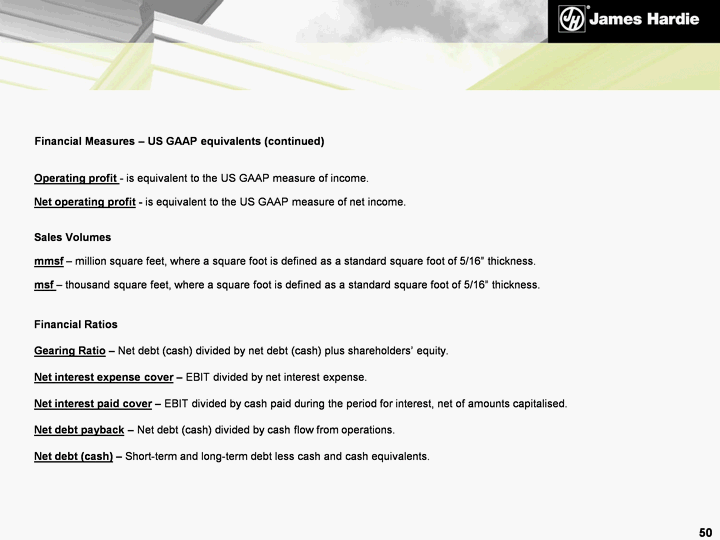
| Financial Measures - US GAAP equivalents (continued) Operating profit - is equivalent to the US GAAP measure of income. Net operating profit - is equivalent to the US GAAP measure of net income. Sales Volumes mmsf - million square feet, where a square foot is defined as a standard square foot of 5/16" thickness. msf - thousand square feet, where a square foot is defined as a standard square foot of 5/16" thickness. Financial Ratios Gearing Ratio - Net debt (cash) divided by net debt (cash) plus shareholders' equity. Net interest expense cover - EBIT divided by net interest expense. Net interest paid cover - EBIT divided by cash paid during the period for interest, net of amounts capitalised. Net debt payback - Net debt (cash) divided by cash flow from operations. Net debt (cash) - Short-term and long-term debt less cash and cash equivalents. 50 |
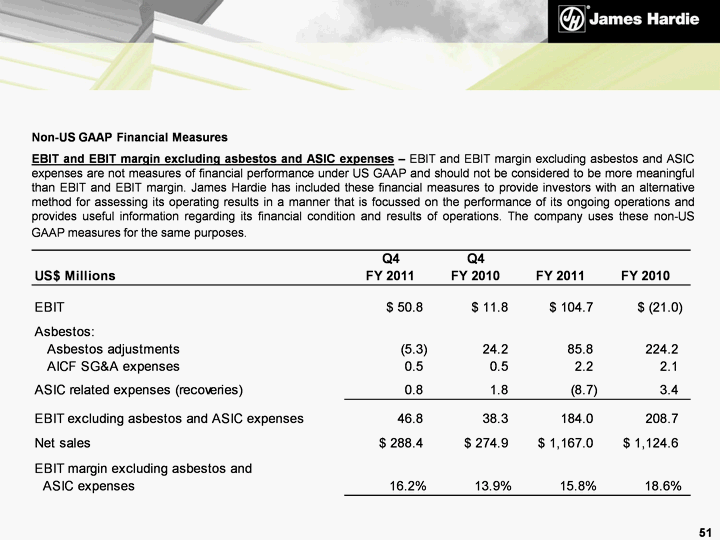
| Non-US GAAP Financial Measures EBIT and EBIT margin excluding asbestos and ASIC expenses - EBIT and EBIT margin excluding asbestos and ASIC expenses are not measures of financial performance under US GAAP and should not be considered to be more meaningful than EBIT and EBIT margin. James Hardie has included these financial measures to provide investors with an alternative method for assessing its operating results in a manner that is focussed on the performance of its ongoing operations and provides useful information regarding its financial condition and results of operations. The company uses these non-US GAAP measures for the same purposes. 51 |
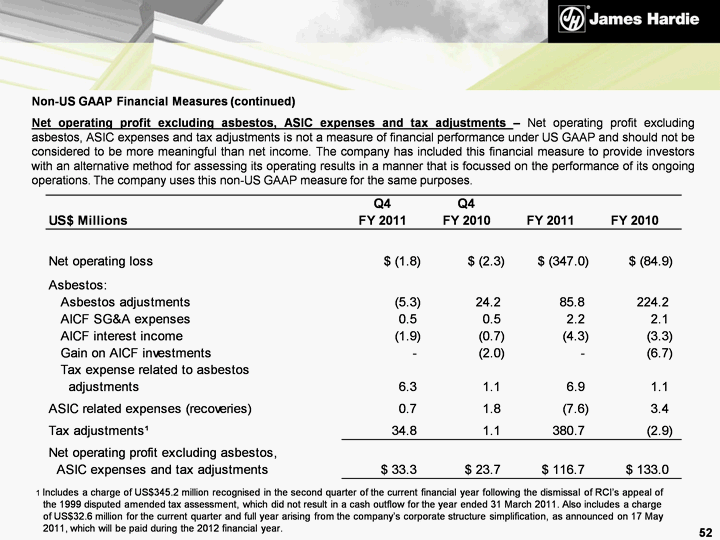
| Non-US GAAP Financial Measures (continued) Net operating profit excluding asbestos, ASIC expenses and tax adjustments - Net operating profit excluding asbestos, ASIC expenses and tax adjustments is not a measure of financial performance under US GAAP and should not be considered to be more meaningful than net income. The company has included this financial measure to provide investors with an alternative method for assessing its operating results in a manner that is focussed on the performance of its ongoing operations. The company uses this non-US GAAP measure for the same purposes. 52 1 Includes a charge of US$345.2 million recognised in the second quarter of the current financial year following the dismissal of RCI's appeal of the 1999 disputed amended tax assessment, which did not result in a cash outflow for the year ended 31 March 2011. Also includes a charge of US$32.6 million for the current quarter and full year arising from the company's corporate structure simplification, as announced on 17 May 2011, which will be paid during the 2012 financial year. |
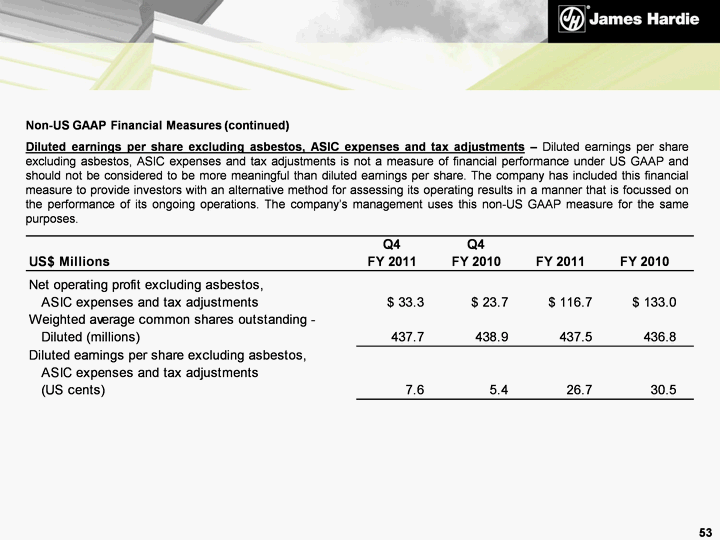
| Non-US GAAP Financial Measures (continued) Diluted earnings per share excluding asbestos, ASIC expenses and tax adjustments - Diluted earnings per share excluding asbestos, ASIC expenses and tax adjustments is not a measure of financial performance under US GAAP and should not be considered to be more meaningful than diluted earnings per share. The company has included this financial measure to provide investors with an alternative method for assessing its operating results in a manner that is focussed on the performance of its ongoing operations. The company's management uses this non-US GAAP measure for the same purposes. 53 |
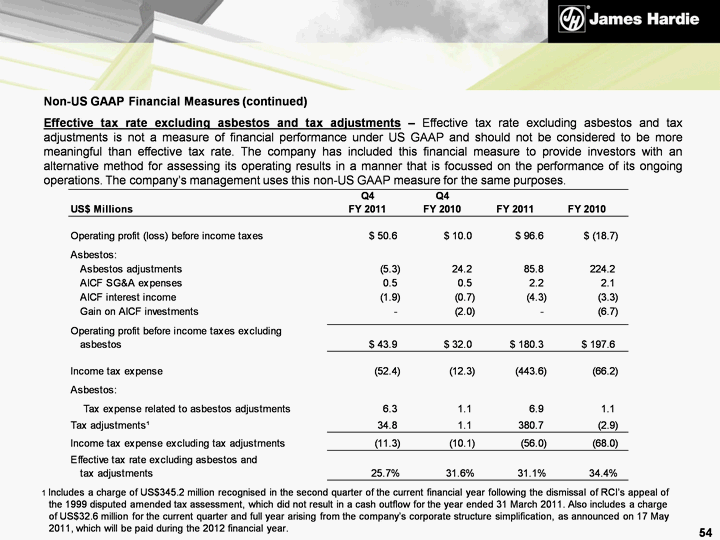
| Non-US GAAP Financial Measures (continued) Effective tax rate excluding asbestos and tax adjustments - Effective tax rate excluding asbestos and tax adjustments is not a measure of financial performance under US GAAP and should not be considered to be more meaningful than effective tax rate. The company has included this financial measure to provide investors with an alternative method for assessing its operating results in a manner that is focussed on the performance of its ongoing operations. The company's management uses this non-US GAAP measure for the same purposes. 54 1 Includes a charge of US$345.2 million recognised in the second quarter of the current financial year following the dismissal of RCI's appeal of the 1999 disputed amended tax assessment, which did not result in a cash outflow for the year ended 31 March 2011. Also includes a charge of US$32.6 million for the current quarter and full year arising from the company's corporate structure simplification, as announced on 17 May 2011, which will be paid during the 2012 financial year. |
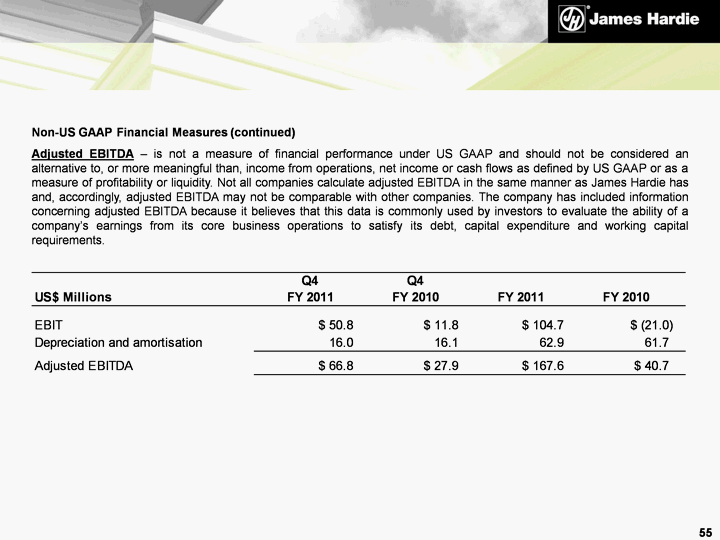
| Non-US GAAP Financial Measures (continued) Adjusted EBITDA - is not a measure of financial performance under US GAAP and should not be considered an alternative to, or more meaningful than, income from operations, net income or cash flows as defined by US GAAP or as a measure of profitability or liquidity. Not all companies calculate adjusted EBITDA in the same manner as James Hardie has and, accordingly, adjusted EBITDA may not be comparable with other companies. The company has included information concerning adjusted EBITDA because it believes that this data is commonly used by investors to evaluate the ability of a company's earnings from its core business operations to satisfy its debt, capital expenditure and working capital requirements. 55 |
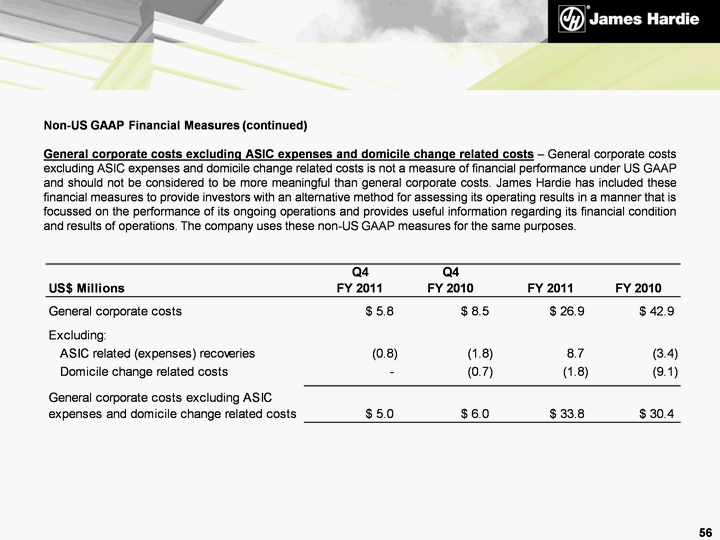
| Non-US GAAP Financial Measures (continued) General corporate costs excluding ASIC expenses and domicile change related costs - General corporate costs excluding ASIC expenses and domicile change related costs is not a measure of financial performance under US GAAP and should not be considered to be more meaningful than general corporate costs. James Hardie has included these financial measures to provide investors with an alternative method for assessing its operating results in a manner that is focussed on the performance of its ongoing operations and provides useful information regarding its financial condition and results of operations. The company uses these non-US GAAP measures for the same purposes. 56 |
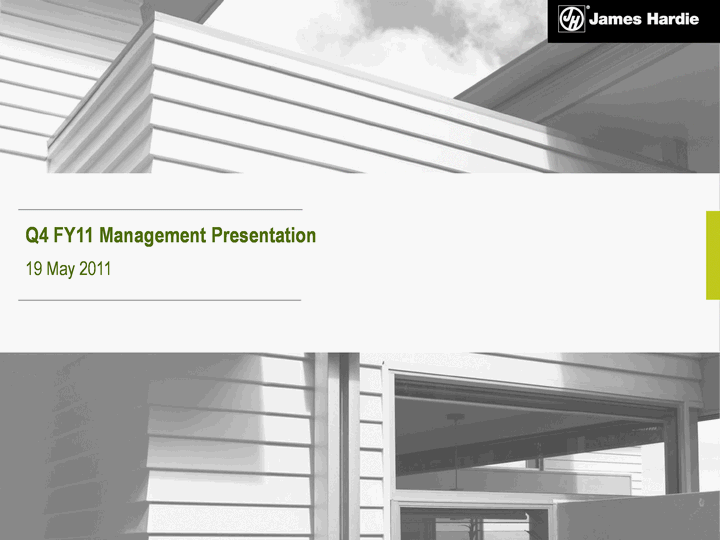
| Q4 FY11 Management Presentation 19 May 2011 |